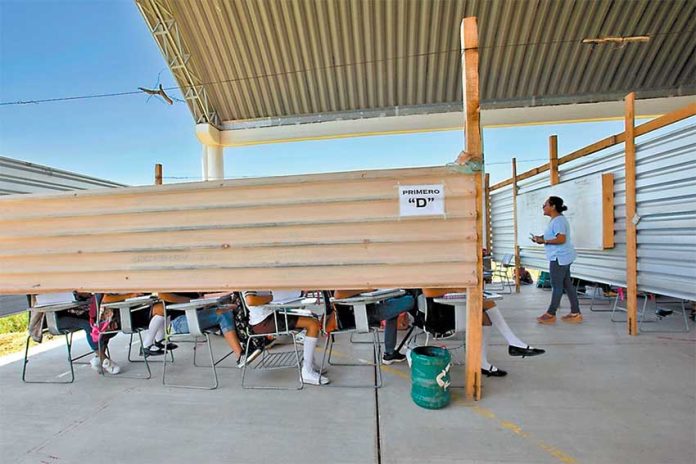Four out of 10 schools in Oaxaca that were damaged in last September’s first devastating earthquake still haven’t been repaired almost a year after the disaster hit, statistics show.
According to data from Iocifed, a state government institute which oversees the construction of education infrastructure, 2,952 schools in Oaxaca — primarily in the Isthmus of Tehuantepec region — sustained some degree of damage in the powerful 8.2-magnitude earthquake that struck just before midnight on September 7, 2017.
Of those, 1,952 have been rebuilt or repaired but the remaining 1,000 are either still under repair or awaiting attention.
In the latter category is the Number 50 Technical Secondary School in Juchitán, where around 800 students attend classes outside under trees, in classrooms that were badly damaged but still haven’t been demolished or in makeshift, partitioned learning spaces built on the basketball court with sheet metal purchased by parents.
The conditions are far from optimal for learning.
In addition to being highly susceptible to seismic activity, the Isthmus of Tehuantepec is one of Mexico’s windiest regions and the capital of the country’s growing wind energy sector.
But while gales are good for making wind turbine blades spin, they are not helpful for middle school students trying to concentrate on the educational task at hand.
Reporters from the newspaper Milenio observed students from one class struggling to keep control of the pages of their notebooks as wind blew while they took dictation in the open air, while swirls of dust and an errant soccer ball from a physical education class created further problems.
“It’s not his fault,” said typing teacher Claudia Torija when a student was struck in the head with the wayward ball.
“It’s the fault of the education authorities that haven’t followed up as they should have. In the news, they said that 100% of schools were ready [for the new school year] but we’ve found out that’s a lie,” she said.
“What you can see over there was the base of a two-meter by five-meter building that housed my workshop and the cafeteria. Today, it’s just dirt where rainwater stagnates. Do you think that a young person is going to learn in these conditions? We get distracted, they get hit by balls . . . .”
Héctor Pineda, the school’s academic coordinator, told Milenio that authorities promised to completely rebuild or repair schools in less than six months after the quake.
But six months passed before rubble was even cleared and any new construction work began, he explained.
“Attention was only given to one school [in Juchitán], the Centro Escolar Juchitán, which is already finished. The rest, well they’re under construction that is a little slow, as you can see. In our case only the foundations of four classrooms have been laid but we need at least 18,” Pineda said.
“They [the students] say themselves, ‘Teacher, our notebooks are all battered, when are we going to have a classroom? It’s cold, it’s too hot, what are we going to do when it starts to rain?’”
Iocifed official Mario Bustillos said the state government has been allocated 1.6 billion pesos (US $82.1 million) to carry out repair work but added that a shortage of construction workers had made the rebuilding process “a little slow.”
José Juan Carrasco, principal of the Number 50 school, said that as in other schools still awaiting repairs, students and teachers have grown desperate for adequate learning conditions.
If the problems continue, the CNTE teachers’ union will start to take extreme measures, he warned.
Source: Milenio (sp)
